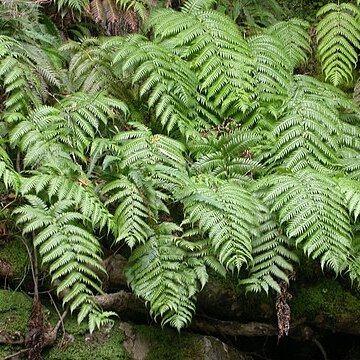Plants terrestrial, of moderate to large size. Rhizome erect or ascending, sometimes creeping, stout, dictyostelic, densely scaly; scales brown, non-clathrate, basifixed. Fronds tufted, long stipitate; lamina deeply bipinnatifid, lower part often pinnate, elliptic in outline, papery or thinly leathery; pinnae pinnatifid, narrowly oblong in outline, gradually becoming narrowly triangular-ovate, sometimes stalked, glabrous, margin entire or serrulate; veins anastomosing to form a series of areoles along costae and costules, free to margin, simple or forked. Sori discrete, linear, elliptic, or crescent-shaped, occupying costular areoles, discrete, attached to outer areole-forming veins, superficial or sunken; indusia dark brown, facing toward costa, thickly papery; sporangia with long stalk, annulus of 17-24 thickened cells. Spores elliptic, perispore rugose.
Petiole about equaling the blade, with 2–several bundles; lvs monomorphic or dimorphic, pinnatifid to pinnate-pinnatifid, the fertile ones, when differentiated, with linear segments; blade sparsely scaly and glandular on the rachis and costae, otherwise glabrous; veins partly anastomosing, forming one or more series of areoles along the midvein of the pinnae or segment; sori superficial (our spp.) or often set in pits, oblong to linear, spanning 2 or more areoles, arranged in a chain-like row on each side of the costa; large bog-ferns with coarse, long-creeping rhizomes and scattered, erect, deciduous lvs. 10, mainly N. Hemisphere.
Plants terrestrial or rarely on rock. Stems long-creeping to erect, slender to stout, not climbing; scales brown. Leaves monomorphic (dimorphic in 1 species), clustered or well separated. Blades pinnate or pinnatifid. Rachises and costae scaly. Veins anastomosing in both sterile and fertile leaves, forming a regular series of areoles along costae and costules, further anastomosing in 1 species. Sori discrete, in chainlike rows along costae or costules, extending only the length of individual areolar veins. Spores with perine irregularly folded. x = 34, 35.
Large ferns, at least bipinnatifid; edges of pinnae not sharply toothed.

